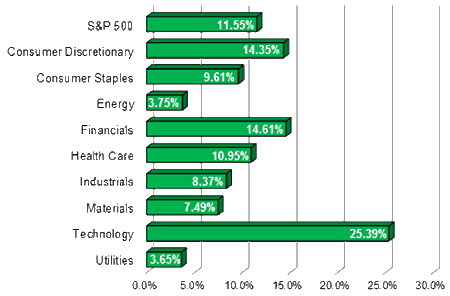
Market Commentary by Scott J. Brown, Ph.D., Chief Economist
 Nonfarm payrolls rose more than expected in July, reducing fears that the economy may be headed back into recession. One shouldn’t put too much weight on any one particular month, especially July. However, the figures are consistent with the broad range of data suggesting moderate growth over the near term – not especially strong, but not terribly weak either.
Nonfarm payrolls rose more than expected in July, reducing fears that the economy may be headed back into recession. One shouldn’t put too much weight on any one particular month, especially July. However, the figures are consistent with the broad range of data suggesting moderate growth over the near term – not especially strong, but not terribly weak either.
At face value, the July payroll increase (+163,000) was consistent with the view that mild winter weather pulled forward seasonal gains that would have occurred in spring and early summer. Nonfarm payrolls averaged a 151,000 gain over the first seven months of 2012, vs. a 153,000 pace in 2011.
Prior to seasonal adjustment, nonfarm payrolls fell by 1.2 million, reflecting the end of the school year. Education jobs (public and private) fell by 1.363 million, while other sectors rose by 159,000. That’s not out of line with what we would normally expect to see in July. The spring and early summer is when firms do most of their hiring. The seasonal pattern this year was not far out of line relative to previous years, but was shifted a bit toward the first few months of the year.Government remained a moderate drag on job growth. State and local government payrolls fell by 7,000 and the federal government lost 2,000. One difference between the current recovery and past recoveries is that government is subtracting from, rather than adding to, overall GDP growth (we’re talking specifically about the GDP components, government consumption and investment, not transfer payments or regulations).
The broad range of recent data continue to suggest an economy that’s expanding fast enough to absorb the growth in the working-age population, but not enough to make up for much of the ground that was lost in the labor market during the downturn. The unemployment rate has fallen over the last couple of years, but that’s largely due to a decrease in labor force participation. As individuals exhaust their unemployment insurance benefits, they tend to give up looking for a job and are no longer officially counted as unemployed. That trend may have played itself out. The unemployment rate has been little changed in recent months. The employment/population ratio, a better gauge of labor utilization, has been trending roughly flat.
Where does this leave Federal Reserve policymakers? The data are not screaming for further accommodation. We’ll get one more employment report before the September 12-13 policy meeting. Unless that report is a disaster, or if there is a renewed threat of deflation, the Fed is likely to stand pat. The Fed could respond to downside risks. However, the fiscal cliff and Europe appear to be somewhat less threatening than they did a month ago. Lawmakers are still unlikely to do anything until after the election, but they are talking about it and seem to appreciate the economic consequences. Avoiding the fiscal cliff means enduring another year of elevated budget deficits, but that’s not a problem for the financial markets (at least for now). The ECB is expected to restart its bond purchase program in September, once again averting an immediate disaster, but not really solving Europe’s underlying problems.
Indices
| Last | Last Week | YTD return % | |
| DJIA | 13165.19 | 12878.88 | 7.76% |
| NASDAQ | 3018.64 | 2909.77 | 15.87% |
| S&P 500 | 1402.80 | 1365.00 | 11.55% |
| MSCI EAFE | 1477.82 | 1417.45 | 4.62% |
| Russell 2000 | 802.90 | 768.60 | 8.37% |
Consumer Money Rates
| Last | 1-year ago | |
| Prime Rate | 3.25 | 3.25 |
| Fed Funds | 0.15 | 0.13 |
| 30-year mortgage | 3.64 | 4.33 |
Currencies
| Last | 1-year ago | |
| Dollars per British Pound | 1.561 | 1.621 |
| Dollars per Euro | 1.228 | 1.423 |
| Japanese Yen per Dollar | 78.690 | 77.090 |
| Canadian Dollars per Dollar | 0.992 | 0.991 |
| Mexican Peso per Dollar | 13.107 | 12.367 |
Commodities
| Last | 1-year ago | |
| Crude Oil | 93.36 | 79.30 |
| Gold | 1615.66 | 1741.03 |
Bond Rates
| Last | 1-month ago | |
| 2-year treasury | 0.26 | 0.25 |
| 10-year treasury | 1.64 | 1.50 |
| 10-year municipal (TEY) | 2.95 | 3.12 |
Treasury Yield Curve – 8/10/2012
S&P Sector Performance (YTD) – 8/10/2012
Economic Calendar
| August 10 |
— |
Import Prices (July) |
| August 14 |
— |
Producer Price Index (July) Retail Sales (July) |
| August 15 |
— |
Consumer Price Index (July) Industrial Production (July) |
| August 16 |
— |
Building Permits, Housing Starts (July) |
| August 17 |
— |
Consumer Sentiment (mid-August) Leading Economic Indicators (July) |
| August 31 |
— |
Bernanke Speech (Jackson Hole) |
| September 3 |
— |
Labor Day Holiday (markets closed) |
| September 6 |
— |
ECB Policy Meeting |
| September 7 |
— |
Employment Report (August) |
| September 13 |
— |
Fed Policy Meeting Bernanke Press Briefing |
Important Disclosures
US government bonds and treasury bills are guaranteed by the US government and, if held to maturity, offer a fixed rate of return and guaranteed principal value. US government bonds are issued and guaranteed as to the timely payment of principal and interest by the federal government. Treasury bills are certificates reflecting short-term (less than one year) obligations of the US government.
Commodities trading is generally considered speculative because of the significant potential for investment loss. Markets for commodities are likely to be volatile and there may be sharp price fluctuations even during periods when prices overall are rising. Specific sector investing can be subject to different and greater risks than more diversified investments.
Tax Equiv Muni yields (TEY) assume a 35% tax rate on triple-A rated, tax-exempt insured revenue bonds.
![]() Material prepared by Raymond James for use by its financial advisors.
Material prepared by Raymond James for use by its financial advisors.
The information contained herein has been obtained from sources considered reliable, but we do not guarantee that the foregoing material is accurate or complete. Data source: Bloomberg, as of close of business August 9th, 2012.
©2012 Raymond James Financial Services, Inc. member FINRA / SIPC.




